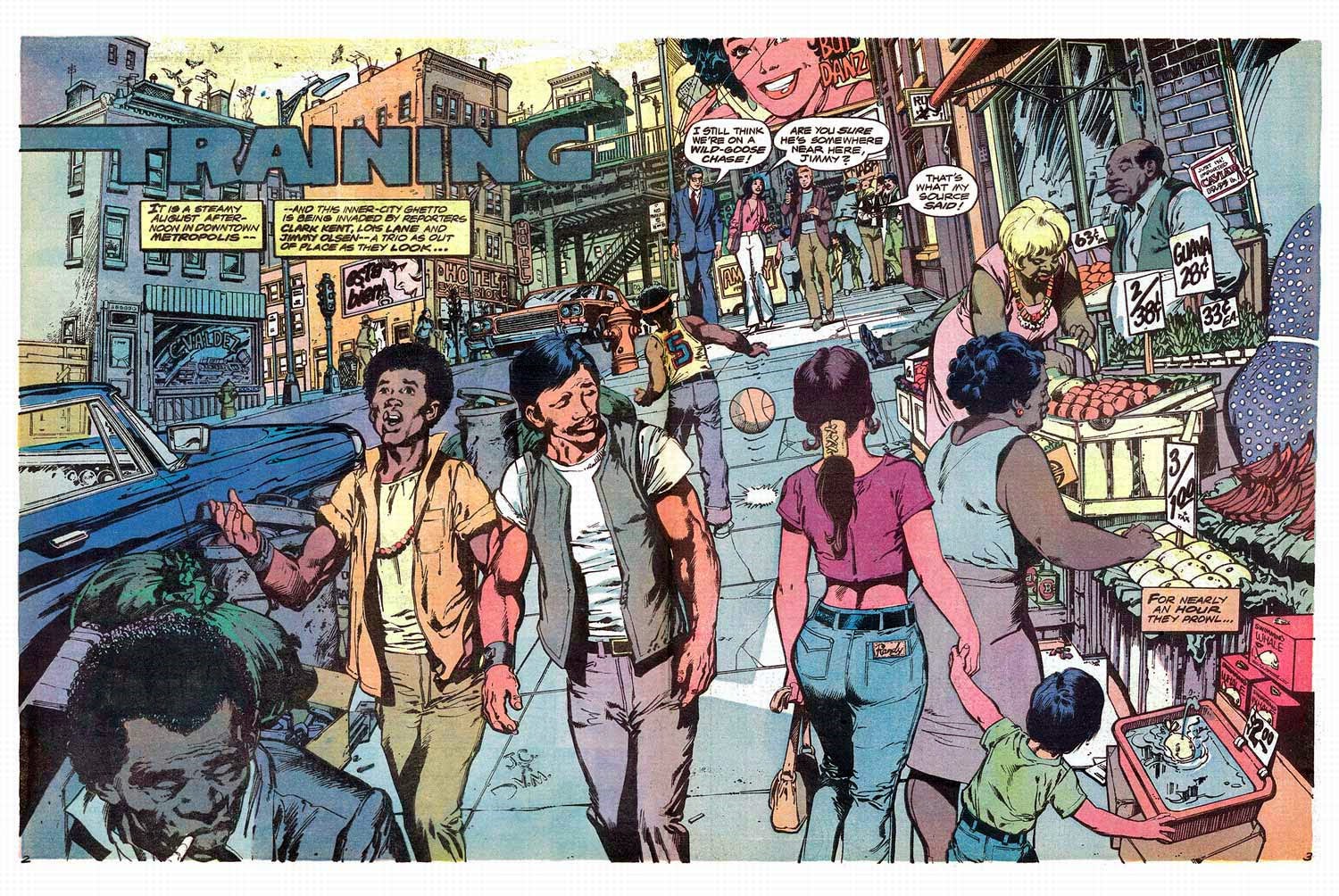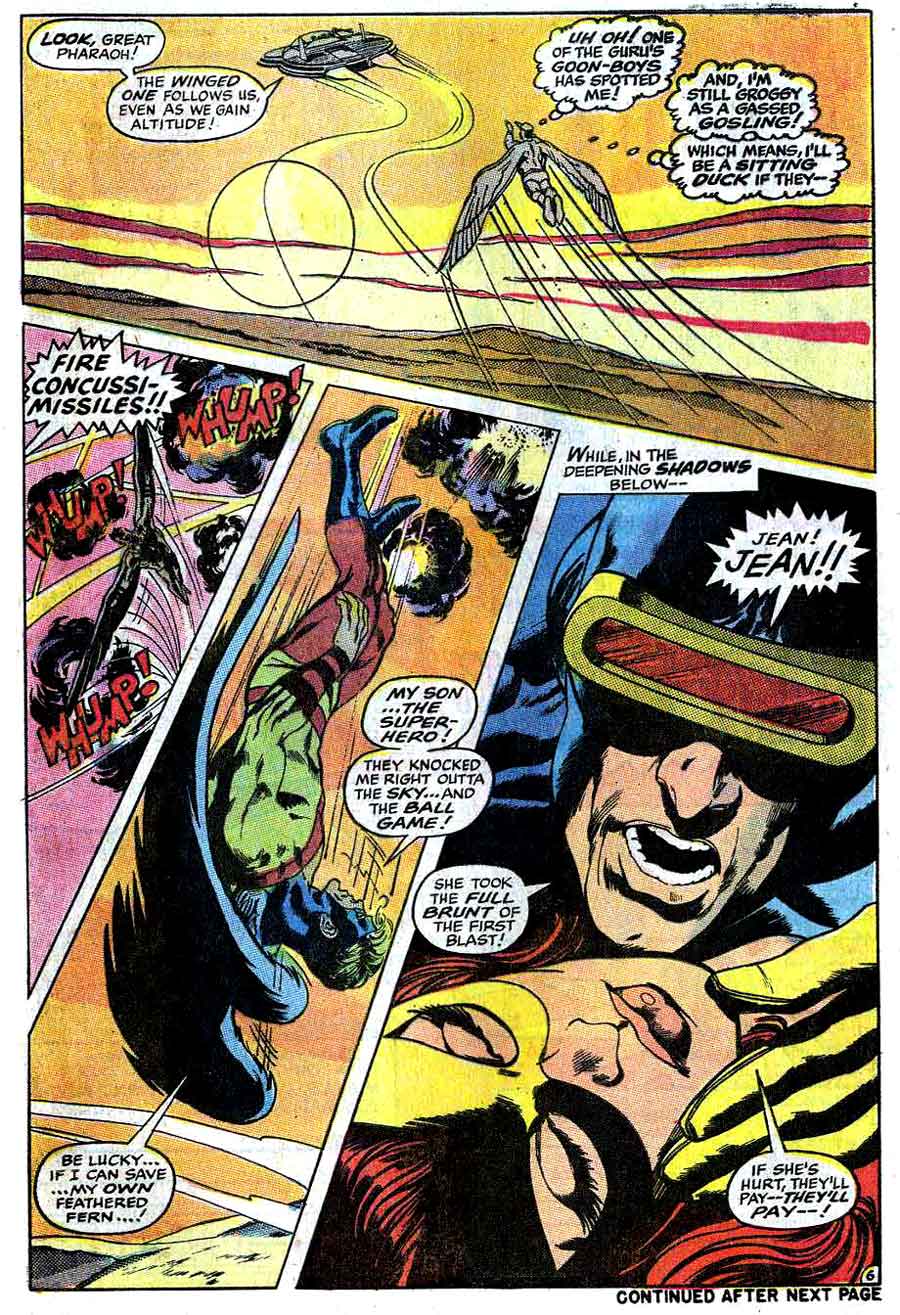|
|
Post by Reptisaurus! on Jun 24, 2018 21:52:39 GMT -5
Alright, so I looked everywhere (everywhere!) on the internet and nobody has made the case against Neal Adams. And SOMEBODY should, and what the hell I'm off work for the next couple days. This will probably be three or four image heavy posts,  Like so. finishing up Tuesday 6/26/18, give or take. Introduction:
There are 3 major points I'm gonna try to prove. (A) Neal Adams was a technically revolutionary artist, who invented more-or-less-out-of-whole-cloth multiple new approach to comics storytelling. (Real quick: He moved the comics page away from simple grids to more complex designs, utilized dizzying changes in the perspective of the "camera" - including an emphasis on very tight close-ups to put the readers just a hair's breadth from the action - and captured the frenzied emotion of the strongest Kurtzman-style cartoonists with his highly realistic style.) Adams changed comic forever and increased the pool of available storytelling approaches for future artist. And he might be, to this day, the best single texture artist to work in American mainstream comics. That is a GREAT $%^&ing drawing of a dinosaur! (B) He was also an artist with a limited skill-set - His relatively realistic, emotion-heavy, style only worked for specific types of stories. (C) His work was vastly influential, so much so that the kinds-of-stories-that-Neal-Adams-can-tell became over-represented in American superhero comics. Since I'm not here to praise Adams as much as bury him, I'll assume that we can all take point (A) on faith. So I'll start with a closer examination of point (B) next. (Although stop me if I've missed anything important about Adams' effect on comic art. Or if you can think of a better word than "texture." I know that's not exactly right but I think you all will understand what I'm getting at.) |
|
|
|
Post by Chris on Jun 24, 2018 22:39:40 GMT -5
As soon as I read the title, I already agreed with you. Reading the post just added to it. Now, I love Adams' art, especially the middle 70s period (his covers for DC and Power Records [the ones he drew himself, that is] are things of wonder. But I definitely have to agree with points B and C here. Any time Adams tries to do anything even slightly cartoony, it looks horrible. In an interview with Amazing Heroes, Gil Kane touched on Adams' influence. Brief comments about Adams are on pgs. 24 & 28, but the entire piece is worth reading. Kane also mentions the prevalence of "advertising techniques" in comics - he doesn't attribute it to Adams, but no doubt Adams was a driving force behind that. It ties in well with your point about "the kinds-of-stories-that-Neal-Adams-can-tell became over-represented in American superhero comics." You can read it here. As for "texture," I'm not sure if it's the right word, but I don't have a better one. However.... A year or so ago, my wife convinced me to watch "The Minority Report." My curiousity about the concept was stronger than my dislike of Tom Cruise, so I watched it, and noticed that a lot of the movie seemd to have high-contrast. It occurred to me that a lot of Adams' work - at least his 60s and early 70s stuff - has a similar look. I know Adams often worked from photos he took, so I wonder if he deliberately took high-contrast photos to increase dramatic lighting, tension, and mood. So, yeah... Adams was great, but too many people went too nuts about his art (myself included, probably). P.S. The opening line of the Gil Kane interview - "It's like an overweight woman squeezing herself into a tight corset: an overabundance of certain qualities being pressed into a very limited area." While Kane wasn't referring to Adams at all, but rather the mood of comics at the time, I think it applies to Adams' influence on comics over the decades. |
|
|
|
Post by BigPapaJoe on Jun 25, 2018 0:23:41 GMT -5
Love Neal Adams. I think he's a top three artist in the industry as far as what he could do with a penicl. For me, his advertising style applied to comics was just incredible. I just think what he brought to the table was sensational. His realistic approach wasn't so much that it lacked dynamism, which I think an artist like Al Williamson lacked to a degree despite the pretty pictures he made. Others will disagree of course. I recently read a book about Luis Garcia Lopez's career (I also put him up there with Adams), and he himself had mentioned while he liked Adams as an artist, he felt that sometimes his work seemed more about the artist, and not the story. He may have been talking about that Ali/Superman book, can't remember exactly. Anyway, I could see how some could think that. Personally I don't, but to each their own. Never thought Adams was a showman or anything like that. He was just really good. I can't think of many artists that could blow the doors off, and put me at the scene quite like Adams did.     What I wouldn't give to be able to draw like he can. Everything just looked so real, but not overdone in a photo/realistic sense. The important information is just still conveyed to me. His level is just so high, I could see why people might think otherwise. |
|
|
|
Post by Reptisaurus! on Jun 25, 2018 0:42:16 GMT -5
Some general caveats and a note on style: EVERY SINGLE FREAKING NEAL ADAMS ARTICLE I READ is all "He returned Batman to his darker roots... blah... blah... blah creature of the night yadda... yadda... yadda.." I don't care. I'm going to concentrate on more general trends in N. A.'s style. I don't care about Adams as a Batman artist or an Inhumans artist or a National Lampoons artist, I care about Adams as a COMIC artist. So there's going to be a different tone to my commentary than most of what you'll read about Neal elsewhere. My discussion here concerns only Adams' Marvel and DC comic book (not magazine) work from the '60s and '70s. Two reasons: (A) That period is by far the most influential and most discussed period of Adams career, and (B) That period is all that I'm familiar with. Toyboy and Ms. Mystic could (for all I know) be 1,000% improvements on Adams' Silver and Bronze age work. And....  When Adams is on, he's on. The above page with Beasty here directly contradicts my next point - And every argument I make should be mentally prefaced with "sometimes he..." and ended with "....but other times he did it perfectly!" So there are two Neal Adamsses. First, there's the crazy experimental design based Neal Adams who whips out a comics page comprised of five septagonal panels surrounding a half oval that's larger on one end with a giant figure of R'as Ah Ghu; overlayed on top of the whole shebang. Then there's the relatively placid "I told Stan I wouldn't scare the kiddies" restrained Neal Adams who works (mostly) within traditional square grids. I'm going to complain about the former for a minute. The crazy design-centric Neal's major flaw is that (sometimes he...) created these weird-ass and wildly original pages that don't serve the story. In the X-Men page the unorthodox panel design emphasizes the vertiginous danger than our X-hero is in, increasing the tension (hell, the terror!) of the page. It's great! But, sadly  This is more common. The twisty, wavy panel borders look cool, but they don't add anything to the narrative; if anything this experamentalism makes the story harder to follow. Where did that spooky tree come from? The X-men page is using creative design as a way to make the story more emotionally gripping, the danger feel more real. The second image is using creative design for it's own sake. Which is fine! It's fine. Honestly, I prefer the twisty panels/magically appearing tree approach to another hacked out 6 panel grid! "Cool looking page designs at least look cool" he enthusiastically tautologied. But this is also the first time in American comics that the utilization of design principles is more important than story. So. Flash forward twenty years. This idea is copied and simplified ad nauseum by artists who don't have Adams' flair for design. What they DO understand isthat "Hey, the art can be more important than the story!" These inferior artists also note Adams' skill at drawing incredibly striking individual panels, images that stay in the reader's mind long after the rest of the story has been forgotten... And you have early Image comics. Art is more important than story. Cool panels full of awesome poses are everything. These ideas were not good for comics. These ideas did not exist before Neal Adams. And this led to another problem; Between Neal's twin fixations on design and cool images, his actual panel-to-panel storytelling often got lost in the mix.  So what the hell is actually going on here? This page wasn't impossible for me to follow but I had to read the text very carefully twice. The most important story beat (the fact that criminals are pupaed up in cocoons that are going to hatch) is conveyed in the smallest panel on the page. And that panel is further de-emphasized by cramming it in the upper right hand corner, while the page is designed to lead the eye downwards. You actually had to stop and search to find the most important story element being conveyed. Now I grant you we are now used to shoddy storytelling. Nothing here seems particularly egregious to the modern comics fan. But in the era of Swans and Ditkos and Romitas and Kuberts and Toths and Decarlos and Bollings storytelling this hard to follow was damn near unheard of.  You can blame some of the problems with this page on the coloring, but there's no denying thatthe character continuity between the first, second, and third panels is really weak, which this makes the whole page hard to follow. There's SOME effort in transitioning focus between lead characters, (the energy lines and the floating legs) but the rapid-fire switching of three POV characters in three panels is jarring.  *Shrug* Honestly I'm still not sure what's happening here. Now I am absolutely cherry picking negative examples here. Neal's story-telling was clear and effective more often than it was obfuscatory or poor - and sometimes it was downright great. But on the downside Adams' panel to panel storytelling was murky or jarring or simply hard to follow far more often than any of his late silver age contemporaries. Adams - and his massive popularity - made it acceptable to focus on aspects of art over telling the story as cleanly as possible... which led (again) directly to Rob Leifeld but is STILL leading to no-sense-of-place-no-sense-of-character storytelling muddles like this.  But that's not the biggest flaw in Neal Adams' work.... |
|
|
|
Post by berkley on Jun 25, 2018 1:00:12 GMT -5
I don't think his style was suited to superhero comics and have long felt he was a bad influence on later artists working in that genre. For all the praise he gets for his realism, I find the distorted anatomy he uses in some panels a distraction that adds nothing in the way of effect (say speed, or power, or dynamism) to make up for its awkwardness (e.g. the 2nd panel of the Deadman page above).
But I love his street scenes like the Superman/Ali two-pager PapaShogun posted, and the covers he did for the DC horror books like House of Secrets. I wish he'd done a good long run on a supernatural series of some kind, or perhaps a detective or spy book - anything where he would be mainly drawing people in street clothes rather than skin-tight superhero costumes.
|
|
|
|
Post by BigPapaJoe on Jun 25, 2018 1:35:28 GMT -5
|
|
|
|
Post by foxley on Jun 25, 2018 2:27:51 GMT -5
So the argument is basically 'sometimes Neal Adams drew stuff I didn't like, therefore he sucks'?
I think I'll pass on the rest of this 'lets piss on Neal Adams' thread.
|
|
|
|
Post by Icctrombone on Jun 25, 2018 5:19:28 GMT -5
I wouldn't say mostly negative, but he worked best with an editor. His highpoint was the Green Lantern series and his low point was the Continuity comic books.
|
|
|
|
Post by Cei-U! on Jun 25, 2018 7:48:48 GMT -5
I feel compelled to point out that most of the background work in that two-page street scene from the Superman/Ali treasury is actually the work of Terry Austin, who was still working at Continuity at the time. It doesn't take away from the beauty of Adams' figure work but credit where credit is due. As for the main premise, I agree with it 100%. Much as I love his work (and I do, as a look through my collection would prove), I've always considered Adams a sub-par storyteller who regularly put page design over narrative clarity. It's a flaw, but not a fatal one. Heck, I've said the same thing about Gene Colan, and he's my all-time favorite.
Cei-U!
I summon the consensus!
|
|
|
|
Post by Icctrombone on Jun 25, 2018 8:02:13 GMT -5
I feel compelled to point out that most of the background work in that two-page street scene from the Superman/Ali treasury is actually the work of Terry Austin, who was still working at Continuity at the time. It doesn't take away from the beauty of Adams' figure work but credit where credit is due. As for the main premise, I agree with it 100%. Much as I love his work (and I do, as a look through my collection would prove), I've always considered Adams a sub-par storyteller who regularly put page design over narrative clarity. It's a flaw, but not a fatal one. Heck, I've said the same thing about Gene Colan, and he's my all-time favorite. Cei-U! I summon the consensus! I always thought this but never said it for fear of criticizing a legend. I don't know how to read some of his pages. |
|
|
|
Post by kirby101 on Jun 25, 2018 8:39:31 GMT -5
Gene Colan was doing the same thing with panel layout in Dr. Strange. Steranko did it as well.
But let's criticize experimentation if it occasional isn't perfectly executed.
His influence gave us Frank Brunner, Bill Sienkiewicz, Mike Kaluta, Jim Starlin and may others.
The premise of this thread isn't supported by history.
What's next? How Kirby was mostly bad for comics?
|
|
|
|
Post by Reptisaurus! on Jun 25, 2018 8:45:05 GMT -5
So the argument is basically 'sometimes Neal Adams drew stuff I didn't like, therefore he sucks'? I think I'll pass on the rest of this 'lets piss on Neal Adams' thread. You are right! "Adams' does not effectively communicate storytelling information, and in this example puts the most important piece of information on the page in a small panel in the upper right hand corner in a way that the eye is not drawn to it" means exactly the same asI hate Neal Adams works and he is awful! Those are 100% synonyms. There is no difference in the intent of those two sentences at all! |
|
|
|
Post by brutalis on Jun 25, 2018 8:47:11 GMT -5
Adams praises are well known and while I gladly admit his influence and style has helped push the artistic boundaries at the time from the simplistic and boring trends of comic books I was only seeing him at the tail end of his comic book career. Most of what I knew of Adams art was from the DC Batman and Green Lantern/Green Arrow stuff and a couple of Avengers and X-Men issues he did, the Superman/Ali and then only seeing his art upon magazine covers thereafter. Personally I think there is more positive than negative to be found in his artwork. We all fail sometimes and it is better to try for something new and creative and have come up short than to just continue doing something "because that is the way it is supposed to be done".
|
|
|
|
Post by Icctrombone on Jun 25, 2018 8:57:37 GMT -5
I haven't noticed the experimentation in this newer stuff, The pages are more straight forward. The writing is the weak point.
|
|
|
|
Post by Reptisaurus! on Jun 25, 2018 9:04:05 GMT -5
Also I couldn't remember where this page was in time but I did want to include it..  The storytelling is spot on here. The intent, emotions, physical location and POV character are completely clear, even though the latter two change. My usual complaint with Adams' storytelling is that you have to read the captions closely to find out what's going on, but here we have 7 words in 8 panels and everything is crystal. Neal Adams absolutely had the chops, and when he was focusing on storytelling he was just great. (Which means that he wasn't always focusing...) |
|